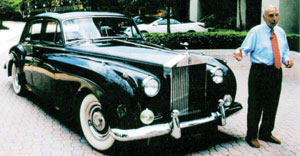
|
|
Optometry mourns the loss of Robert J. Morrison, OD, a pioneer of soft contact lenses and “the eye doctor of the rich and famous,” who died January 7 at the age of 90.
In the early 1960s, Dr. Morrison became aware of the work by Czech chemist Otto Wichterle on the hydrophilic polymer HEMA. He traveled to the former Czechoslovakia to apply this material in the development of a soft contact lens. Dr. Morrison became a co-patent holder in the Western hemisphere for this technology. The patent was sold to Bausch + Lomb, which launched the original Soflens in 1971. Dr. Morrison’s expertise in contact lenses brought an international clientele to his practice in Harrisburg, Pa., from celebrities in Hollywood to royal families throughout Europe—he once received a Rolls Royce from Queen Juliana of the Netherlands as payment for his services. In 1993, Morrison launched Morr-Sight, a mobile clinic for providing free eyewear to deserving people around the world. In 1995, he founded eyeglass.com, an online eyewear retailer.
University of Central Arkansas will begin a feasibility study to assess the possibility of a new school of optometry on its campus. A consulting group will provide an analysis of the pros and cons of developing a school of optometry at UCA. The study is scheduled to be completed by May 31.
|
|
 |
Optometry Office Gets ‘Drive-Thru’ Window
A driver pulled her SUV into the wrong lane, swerved to avoid oncoming traffic and collided with three parked vehicles—two of which belonged to employees of Vision Quest Eye Clinic, in Hammond, Ind. The impact was so great that it launched one of those vehicles through the front window of the office, says the practice’s owner Alexander Kouklakis, OD.
Fortunately, nobody was injured, according to another doctor at the practice, Megan Mosely, OD, who managed to snap this picture of the damage.
Dry Eye Implant Stimulates Tear Production
A company called Oculeve, which came out of the Stanford Biodesign program, has developed a tiny electronic implant that would boost tear production in dry eye patients who don’t make enough tears.

|
|
| Photo: Michael Ackermann, PhD |
|
The device is designed to deliver small electrical currents to the lacrimal nerve, which induces tear production and provides symptomatic lubrication. Investigators are testing two models of the device: One is inserted into the mucous membrane in the nasal cavity, and the other is implanted under the skin below the eyebrow. Patients can then use a wireless controller to manually adjust the frequency of their tears.
Clinical trials of the implant are underway in Australia, New Zealand and Mexico. In the United States, Oculeve completed a Phase I trial in December 2014, but has yet to announce its results.
